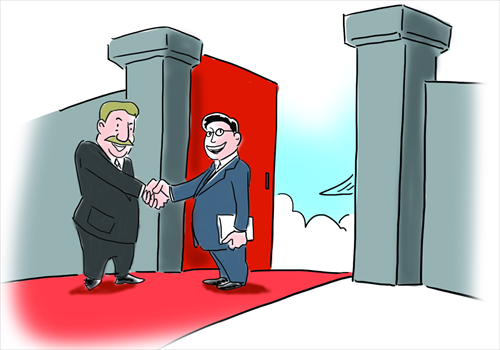Putin’s Eurasian hopes fit China’s needs

Illustration: Liu Rui/GT
The Shanghai Cooperation Organization (SCO) began its two-day annual summit in Tashkent, Uzbekistan on Thursday. Prior to the meeting, Russian President Vladimir Putin announced his upcoming trip to China. The arrangement shows that China and Russia have reached a consensus on issues such as SCO expansion and its future development trajectory and the bilateral relationship will achieve a breakthrough during Putin's visit.
Putin's main objective in this visit was already revealed at the St. Petersburg International Economic Forum a few days ago. The forum gives Russia a stage to present its national development strategies, and it was there that Putin introduced his Greater Eurasia plan. According to Putin, since June China and Russia have begun to discuss establishing a comprehensive trade and economic partnership in Eurasia that includes the Eurasian Economic Union (EEU) and China.
In May, 2015, leaders from the two countries released a joint statement about integrating China's Silk Road Economic Belt initiative with Russia's aspirations under the EEU framework. Despite positive assessment of this program by both Chinese and Russian academia, the two countries did not find a way to realize it. Over the year, obstacles have emerged.
Over the past year, the two countries at governmental and academic levels discussed various ways to link the two initiatives. It was not the first time that the Greater Eurasian partnership, which Putin introduced at St. Petersburg, was put forward. In March, a report titled "Toward the Great Ocean 4: Turn to the East" issued by the Valdai Discussion Club articulated this notion in details. Russia has viewed the Greater Eurasian partnership as an important way to link the Silk Road Economic Belt with the EEU.
The core participants in the Putin-articulated Greater Eurasian partnership include the Russia-led EEU, China, and possibly India and Iran. For Russia, Putin is aiming at expanding the sphere of the EEU from the post-Soviet region to the whole of Central and East Asia.
The Greater Eurasian proposal includes three aspects - security pattern, common market and internal governance. For a long time, the Russian elites have believed that the security pattern in Central Asia and environs does not fit the integration trend of regional economy and the region lacks a security mechanism like the Organization for Security and Co-operation in Europe (OSCE). They suggest imitating the OSCE model and holding forums about regional development, cooperation and security. They want to create an Asian OSCE within the framework of the Greater Eurasian partnership.
The economic crisis between 2014 and 2016 dealt a heavy blow to stability and order of the post-Soviet region. Political instability has emerged in Central Asian countries due to economic fluctuation. Russia has realized that it needs to deal with potential instability in Central Asia by developing the economy.
In the economic sphere, the Greater Eurasian partnership aims to set up a common market, which is in line with China's Silk Road Economic Belt and serves as the foundation of the integration of the Silk Road Economic Belt and the EEU.
The internal governance within the Greater Eurasian partnership respects the existing system of all countries, maintains sovereign integrity and prevents the re-emergence of color revolutions in the region. The proposal of the Greater Eurasian partnership reflects the thinking of the Russian elites about the future path of the sphere. Although Russia's strength has weakened in recent years, as a past superpower, its ability to design systems is worth studying by other emerging countries.
Russia's Greater Eurasian partnership may not tally with China's interests. Russia does not want to see China unilaterally engage with Central Asian countries to advance its Silk Road Economic Belt construction, and the new partnership means discussion about integration of the Silk Road Economic Belt and the EEU should be held at a multilateral platform.
Fortunately, Russia has faced up to the reality that China's influence is growing in Eurasia. As long as Russia's clout is not threatened, Moscow accepts Beijing's involvement in Central Asian affairs but insists on maintaining its dominance in Central Asia. Russia has gradually accepted China's Silk Road Economic Belt initiative, which indicates that the bilateral mutual trust is deepening.
The author is a PhD candidate at the Center for Russian Studies, East China Normal University. opinion@globaltimes.com.cn Follow us on Twitter @GTopinion